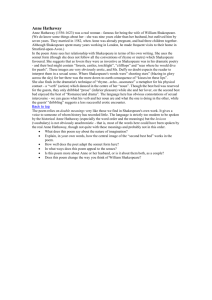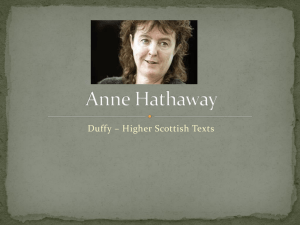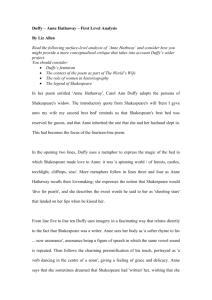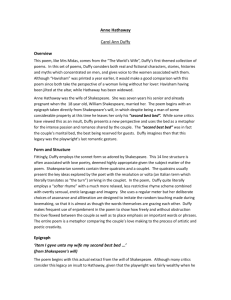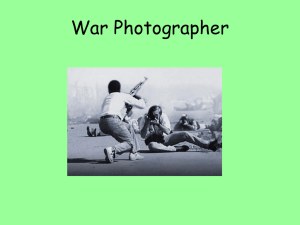Anne Hathaway
advertisement
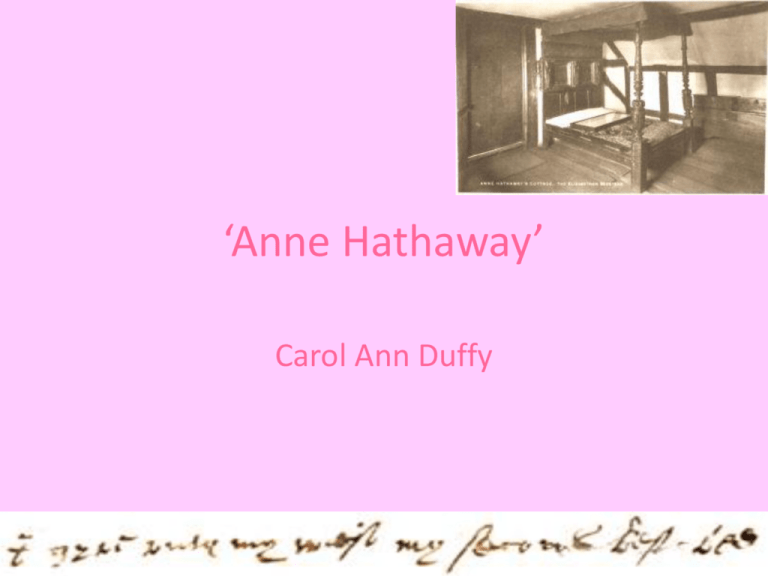
‘Anne Hathaway’ Carol Ann Duffy Overview This poem, like ‘Mrs Midas’, comes from ‘The World’s Wife’, Duffy’s first themed collection of poems. In this set of poems, Duffy considers both real and fictional characters, stories, histories and myths that focus on men, and gives voice to the women associated with them. In this collection, Duffy writes a number of dramatic monologues from the perspective of women who have been traditionally silenced in history, mythology and fiction. A dramatic monologue is a poem that is spoken by a character. The monologues are essentially giving a voice back to these women, and at the same time allowing us to see the men in their lives from a different view point. The poem portrays both genders are equal in the relationship. The enjambment of "I held him" and "he held me" portrays how both are equivocal to each other and a sense of equality is restored. Although ‘Havisham' was published a year earlier, it makes a good comparison with this poem since both take the perspective of a woman living without her lover - Havisham having been jilted at the altar, while Hathaway has been widowed. Anne Hathaway • Born 1555/56 – Died 6th of August 1623 • Married William Shakespeare in November 1582. • She was already pregnant with their first child. • She was 7 years older than Shakespeare who was 18 when they married. • Like ‘Mrs Midas’, this poem gives voice to and empowers the female figures from the narrative of our past. Sonnet Form 14 lines. Often associated with the theme of love. A Shakespearean Sonnet consists of 3 quatrains with a set rhyming scheme and a rhyming couplet at the end. The quatrains usually present the key ideas explored by the poet with the resolution or 'volta' (an Italian term which literally translates as: the turn) arriving in the couplet. In the poem, Duffy employs a softer rhyme with a much more relaxed, less restrictive rhyme scheme, combined with overtly sensual, erotic language and imagery. She uses a regular meter but her deliberate choices of assonance and alliteration are designed to imitate the lovers’ caresses, so that it is almost as though the words themselves are grazing each other. Shakespeare wrote sonnets of iambic pentameter but with a much more disciplined structure. Duffy’s choice to subvert the form of the sonnet emphasises that these are the words of his wife and represent her own insight into her husband, an insight that cannot be shared or replicated by anyone else. Techniques which are used throughout … Metaphor The full poem is a metaphor for their love and passion. The narrator compares their love and sexual relationship to poetry and the art of writing, suggesting that their love is deeper and more meaningful than many critics assumed. Enjambment and unusual rhyming scheme Very few of these lines end with a full stop and the rhyme of this sonnet is not as restricted as a traditional sonnet. This is to mirror the sensuality, fluidity and freedom of their love. The lines tend to end mid sentence but on the most seductive and passionate words. In their relationship, the couple found something precious and valuable, ‘Item I gyveby unto wife my bestsensual bed…’ tone is continued in the as implied themy pearls. Thissecond intimate, (from Shakespeare’s metaphor comparing will) her lover’s words to shooting stars which fell to earth as kisses. The bed we loved in was a spinning world of forests, castles, torchlight, seas language and poetry, which Hathaway was seduced by clifftops, her lover’s where wouldtodive pearls. My lover’saswords literallyhe seems fallfor from the heavens though a gift from the gods were stars which fell physical to earth as kisses beforeshooting transforming into the touch of a kiss. In this opening quatrain then, Duffy clearly illustrates the intensity of the romantic, passionate relationship of the two lovers. Much of the imagery in this poem is sexual and allows us to see the Duffy imagines, then, thatintimacy this legacy was the playwright’s lastfor Dare focuses on the between the couple. relationship between husband and wife as one that is both spiritually Lines only loosely joined together through assonance, The Fairy-tale/mystical/magical poem begins with scene/imagery an epigraph creates taken the directly intensity from of Describing her husband as a ‘lover’ again suggests their romantic gesture Theirs was acreates marriage of equality. He left her hisand Euphemism/metaphor of ‘divingand for pearls.’ ‘Pearls’ and physically fulfilling. She a fantasy landscape where Sibilance. The ‘s’ sound is soft and seductive just like Shakespeare example “world” and “words”. Softly subtly joined together, Shakespeare’s their love/connection. will. While ‘Spinning’ some suggests critics have how intoxicating/allviewed this as an physical relationship was vital and exciting. This is given as best bed because itwhich was the one in which they had enacted = precious jewels suggests his deep Shakespeare’s writing and his love for Anne are intertwined. hissecond writing. Could also represent fireworks to suggest the passion if to echo their tenderness. insult, consuming Duffy their presents love was a new – almost perspective, as if when using together, the they bed were asinThe atheir further emphasis by the words ‘spinning’, ‘shooting’, ‘dancing’ in a very real sense thea drama of their relationship. Duffy usesneatly her love/desire for her. idea of a bed being ‘spinning world’ is striking: Duffy marriage. metaphor transported for off the to/created intense some passion other and world romance together. shared Long by listof the and ‘laughing’. poem to bed try and the assumptions presents as achallenge microcosmic centre of anmarital imaginative, Usethen ofthe half-rhyme confirms this isfact a stereotypical more relaxed version of the couple. images The here second exemplifies best this bed too was – in intense, thenever couple’s ceasing etc.bed, about Shakespeare’s wife. She reimagines the gifteasy ofclifftops, the second expansive universe ‘of forests, castles, torchlight, seas’ Sonnet and echoes how their relationship was and not the while the best was reserved for guests. ‘My’ conveys sense of pride and possession best bed,perhaps not asit awas demonstration of marital discontent, as alluding topetty S’s plays ‘As You Like It’, ‘Macbeth’ etc. but =shared aetc. link one made out to be after his will wasmutual, released Usedifficult of ‘we’ suggests equality in relationship and their the place these where iconic husband and of wife experienced theirpoetry most romantic between works literature and the their love love – both felt the same powerful emotions. and intimate created (bothmoments. literally and metaphorically.) on these lips; my body now a softer rhyme to his, now echo, assonance; his touch a verb dancing in the centre of a noun. Some nights, I dreamed he’d written me, the bed Hathaway states that her lover’s words ‘echo’ as ‘assonance’ In keeping with the expression of a separate identity, Anne Hathaway is Anne toowords that, ‘on’, like ‘body’, the characters in his plays, in her imagines head. The ‘softer’, ‘to’, ‘echo’, presented as someone who is able to use words in an impressively Thelanguage reference again to the bedallatlinked the Continuing the metaphor. Suggesting that she feminine Shakespeare has 'written her', suggesting that itassonance; isis only when ‘assonance’, ‘touch’ and ‘noun’ are by poetic way. In this sense her personality rhymes with her husband’s. end of line eight creates athrough link theimagination while Shakespeare was masculine. She wasto powerless touch. she regards herself through his eyes and that she the ‘o’ sound does indeed echo the lines to as his a softer She refers to her body being a ‘softer rhyme’ to Shakespeare. This opening line of the poem and Enjambment. She finds his touch exciting and erotic. “dancing” = his feels fully alive. rhyme. Alludes to sexual gratification? deliberate comparison their love to something and, in reinforces theelevates symbolic significance touch – moving, unpredictable, exciting. A verb =ofvital to apoetic sentence doing so, literary become loaded the bedterms as representation of sensuality. their and here is imbedded the noun – with can’t function each Alsoit suggests thatain she barely recognises herself without as a separate love. other. The line also alerts of Shakespeare’s most from famous being anymore – it’s us liketoa one dream/feels so far removed who Here, Duffy is subtly relating the poetic techniques of masculine rhyme means she of energising he would often turn into used to belanguage; without him as he is such announs integral patverbs. of her andalso feminine rhyme the actual lives oftotwo people who could hardly They complete onetoanother – allusion sex. life/being. Use of ‘now’ suggests life/r.ship with S. was be separated from art: ‘kisses’ at the end of line 4 is a feminine ending; vibrant/intoxicating. ‘touch’ is a masculine one. The imagery of imagination and words continues into the second half of the poem but with a less exotic, more muted expression. This is fitting as the poem makes the transition from physical and imaginative vitality to the revelation of the idea behind the second best bed and finally to the expression of loss and grief. Her dreaming continues the motif of imagination which ends the poem with his continued life in her memory, and begins the notion of sleep which ends finally in death. a page beneath his writer’s hands. Romance and drama played by touch, by scent, by taste. In the other bed, the best, our guests dozed on, dribbling their prose. My living laughing love – end ofcontrast, this quatrain, Duffy employs elongated alliteration of in their the InAtathe marked she compares the poetry and sensuality phrase tocontinues emphasise how metaphor vividly and r.ship with‘living thoselaughing who in the other bed.the In again aextended withering, disparaging The enjambment from slept linelove’ eight clearly speaker canthat recall their passion, suggesting her on lover comment she asserts they only capable of that dribbling their from the the previous quatrain (bed is are compared to the parchment continues in ‘romance’ some ways exist and survive memory. prose. which theword passion and excitement so associated with the The istodeliberately placedinather the endplaywright of wasthe written.) line to emphasise that this is what she most The dash creates aclear pause to allow(and usThe totheir reflect ontouch, this idea and The implication - poetry r.ship by extension) associates withis their relationship. senses prepare usthe for the resolution finaljust =played awhile dramatic symbolises most skilful and and creative use ofcouplet. language prose All the romance and drama contained inthe these pages was out scent, and taste are employed to reinforce how vividly pause to their stress theand contrast between vitality ofutilitarian their living others) byrelationship, comparison isthough ordinary, or(relationships begun on bed, again Duffy implies that thethrough inspiration forand she can stillofrecall their asthe relationship the realisation that he now can only livecreativity on in her unexceptional. Parenthesis of ‘thetheir best’ iscan her mocking those who his characters to and plots camememories from love where S’s immersing herself in these she experience mind. suggest the bedonce sheand was left was when in the supposedly ‘best’ was thenpassion actualised brought toinferior, existence in his work. this more. bed it is devoid of passion etc. I hold him in the casket of my widow’s head as he held me upon that next best bed. The metaphor of holding her lover the protective casket of her Continued tenderness for in him their and The final couplet ends with the masculine full mirrors rhyme of ‘head’ ‘bed’ imagination reiterates the idea presented in the previous line that, in tenderness withconclusion one another ‘I hold him as relationship he to provide a defined to in thelife: poem and their – our way, our memory of a deceased loved one allows their held me.’ only through death would they part (contrary to public’s view.) Final continued existence. rhyme is plosive and harsh and definite just like the end of their Simile – She his felt secure in histhe hold and he held marriage, through death and pain/agony thisherwould have Duffy seems to suggest that this is much more fitting tightly as she promises to do to his memory now.than an urn or caused. coffin which, although they may contain the physical remnants of a body, can never capture the energy or vitality of the person's character. By remembering her husband, and replaying her memories of their passion, the speaker is really honouring his true legacy and repaying him for the way that he held her in ‘that next best bed.’ It is fitting that Anne Hathaway writes in the form that her husband so famously used. This in itself is an act of homage and, possibly, a means of keeping him alive. Shakespeare’s famous sonnet 18 concludes with ‘So long lives this and this gives life to thee’, which voices the commonly held view that humans might die but a work of art can last forever, effectively immortalising its subject. Themes • passion • sensual erotic love • death and remembrance In the poem, Duffy concentrates on conveying that this was a marriage based on an all - encompassing, deeply physical relationship. She uses the physical legacy of the bed left by Shakespeare to his wife to meditate on this specific aspect of their relationship. In doing so, she presents a couple completely in tune with each other both sexually and emotionally. Fittingly, in a poem about the world’s greatest ever poet and wordsmith, she uses language itself as an extended metaphor to convey the intensity of their passion. As well as emphasising the profound physical connection of the lovers, Duffy also considers that the most fitting way to honour our dead loved ones is by preserving the most enduring, vivid aspects of their character in our memories, thus allowing them to continue to survive. Links with other poems • ‘Havisham’ - both tell the story of a woman’s life after love/a relationship. • ‘Mrs Midas’ – Both have a famous spouse and are described from the woman’s perspective. • Valentine – Unusual perspective of poet on a topic (Love.) • ‘Originally’ and ‘War Photographer’ – looking back/reflecting on past experiences to understand who you now are or how you have reached this point. • Use your grid to track the similarities and differences of the poems we have already studied.
